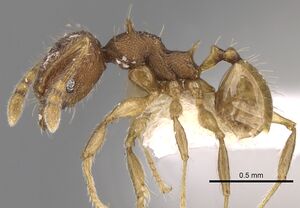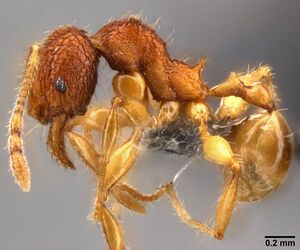Pheidole angulicollis
| Pheidole angulicollis | |
|---|---|

| |
| Scientific classification | |
| Kingdom: | Animalia |
| Phylum: | Arthropoda |
| Class: | Insecta |
| Order: | Hymenoptera |
| Family: | Formicidae |
| Subfamily: | Myrmicinae |
| Tribe: | Attini |
| Genus: | Pheidole |
| Species: | P. angulicollis |
| Binomial name | |
| Pheidole angulicollis Eguchi, 2001 | |
This species inhabits well-developed forests in lowlands and hill areas. A colony collected from Mahua Waterfall area (Eg00-BOR-100) nested in the soil under a stone, and consisted of only one dealate queen, majors, minors and immatures. (Eguchi 2001)
Identification
Eguchi (2001) - This species is very peculiar among Indo-Chinese and Indo-Malayan congeners in having the following characteristics in the major: each dorsolateral portion of promesonotal dome develops into a stout horn on each side; head without frontal carina and antennal scrobe; eye relatively small; postpetiole relatively large.
Subcastes collected from the Mahua Waterfall area are much larger in size and darker in color than those from Lambir; horns on promesonotal dome of the major are well developed in the latter than in the former.
Keys including this Species
- Key to Pheidole majors and minors of Borneo
- Key to Pheidole majors of Borneo
- Key to Pheidole minors of Borneo
Distribution
Latitudinal Distribution Pattern
Latitudinal Range: 5.66667° to 4.198385°.
| North Temperate |
North Subtropical |
Tropical | South Subtropical |
South Temperate |
- Source: AntMaps
Distribution based on Regional Taxon Lists
Indo-Australian Region: Borneo (type locality), Indonesia, Malaysia.
Distribution based on AntMaps
Distribution based on AntWeb specimens
Check data from AntWeb
Countries Occupied
| Number of countries occupied by this species based on AntWiki Regional Taxon Lists. In general, fewer countries occupied indicates a narrower range, while more countries indicates a more widespread species. |

|
Estimated Abundance
| Relative abundance based on number of AntMaps records per species (this species within the purple bar). Fewer records (to the left) indicates a less abundant/encountered species while more records (to the right) indicates more abundant/encountered species. |

|
Biology
Castes
Worker
Minor
Images from AntWeb
   
| |
| Worker. Specimen code casent0281627. Photographer Shannon Hartman, uploaded by California Academy of Sciences. | Owned by NHMUK, London, UK. |
   
| |
| Not Provided. Worker. Specimen code casent0282600. Photographer Adam Lazarus, uploaded by California Academy of Sciences. | Owned by EPEC. |
   
| |
| Paratype of Pheidole angulicollis. Worker. Specimen code casent0901622. Photographer Ryan Perry, uploaded by California Academy of Sciences. | Owned by NHMUK, London, UK. |
Major
Images from AntWeb
   
| |
| Paratype of Pheidole angulicollis. Worker (major/soldier). Specimen code casent0901623. Photographer Ryan Perry, uploaded by California Academy of Sciences. | Owned by NHMUK, London, UK. |
Nomenclature
The following information is derived from Barry Bolton's Online Catalogue of the Ants of the World.
- angulicollis. Pheidole angulicollis Eguchi, 2001b: 30, fig. 5 (s.w.q.) BORNEO.
Unless otherwise noted the text for the remainder of this section is reported from the publication that includes the original description.
Description
Worker
Major Measurements and indices (n=9): TL 2.6-3.6 mm, HL 1.26-1.93 mm, HW 1.11-1.66 mm, SL 0.58-0.76 mm, FL 0.72-1.05 mm, CI 84-88, SI 46-54, FI 63-66. Head broadest at around 1/2-3/5 distance of head (as measured from the mid-point of a transverse line spanning the anteriormost and posteriormost projecting points, respectively (Fig. 5A), in profile not impressed on vertex (Fig. 5B). Hypostoma bearing three distinct median processes, of which medianmost one is stout (Fig. 5C). Clypeus without a median longitudinal carina, with anterior margin weakly concave medially. Eye situated just in front of 1/3 distance of head; distance between mandibular insertion and anterior margin of eye 2.1-2.6 times as long as maximal diameter of eye. Frontal carina inconspicuous, extending backward to 1/3-2/3 distance of head. Antennal scrobe present only around antennal insertion. Antenna with 3-segmented club; scape extending backward to 1/2-3/5 distance of head; terminal segment 1.0-1.1 times as long as preceding two segments together. Masticatory margin of mandible with apical and preapical teeth, and a denticle in front of basal angle. Promesonotum forming a high dome, with a small or inconspicuous prominence on its posterior declivity (Fig. 5E); the prominence in anterior view not concave medially; each dorsolateral portion of the dome produced as a stout horn directing dorsolaterally on each side (Fig. 5D, E). Mesopleuron without a distinct transverse impression. Propodeal spine horn-like, 3.0-4.5 times as long as diameter of propodeal spiracle. Petiole 1.2-1.3 times as long as postpetiole (excluding helcium); petiolar node high, in posterior view not emarginate at apex. Postpetiole 2.3-2.8 times as broad as petiolar node.
Frons and gena longitudinally rugose; vertex, and dorsal and lateral faces of occipital lobe reticulate, with enclosures smooth and shining or weakly punctured; anterior face of promesonotum smooth and shining; remainder of promesonotal dome irregularly rugoso-reticulate; mesopleuron and lateral face of propodeum rugoso-reticulate weakly and shining, or punctured and dull; petiole weakly punctured laterally, and smooth and shining dorsally; postpetiole smooth and shining; or its dorsal face rugose transversely with punctured and dull interspaces, and lateral face punctured; at least anterior part of first gastral tergite weakly or conspicuously punctured and weakly shining. Outer face of mandible covered with decumbent hairs, which are 0.07-0.12 mm in length and longer than distance between piligerous punctures. Body reddish-brown with darker head, or dark reddish-brown with lateral faces of alitrunk, waist and abdomen brown; antennae and legs lighter than alitrunk.
Minor Measurements and indices (n=10): TL 1.3-2.4 mm, HL 0.50-0.68 mm, HW 0.47-0.62 mm, SL 0.48-0.65 mm, AL 0.67-0.90 mm, FL 0.49-0.73 mm, CI 91-96, SI 101-106, FI 104-117. Head in full-face view with slightly concave posterior margin (Fig. 5F); occipital carina evanescent dorsally on head. Clypeus with a weak median longitudinal carina, with anterior margin in full-face view slightly convex medially. Eye situated just in front of midlength of head; distance between mandibular insertion and the anterior margin of eye ca. 1.1 times as long as maximal diameter of eye. Frontal carina and antennal scrobe present only around antennal insertion. Antenna with 3-segmented club; scape extending beyond posterior border of head by its 1/S-1/4 length; terminal segment almost as long as preceding two segments together. Promesonotum forming a low and weakly convex dome, with a pair of low but distinct tubercles; posterior declivity of the dome at most with an inconspicuous prominence (Fig. 5G). Mesopleuron without a distinct transverse impression. Propodeal spine hornlike, 3-3.S times as long as diameter of propodeal spiracle. Petiole 1.2-1.3 times as long as postpetiole (excluding helcium); petiolar node high, in posterior view not emarginate at apex. Postpetiole 2.0-2.2 times as broad as petiolar node.
Clypeus smooth and shining, or very weakly punctured and weakly shining with several rugulae; remainder of dorsal face of head above subocular level weakly rugoso-reticulate, with enclosures smooth and shining or punctured and dull; ventral face of head below subocular level punctured and dull, or reticulate with enclosures very weakly punctured; dorsum of promesonotum reticulate, with enclosures smooth and shining or punctured and dull; remainder of alitrunk punctured and dull; lateral face of petiolar pedicel weakly punctured; dorsum of petiole, and postpetiole and gaster smooth and shining. Body yellowish-brown to brown with lighter waist and gaster; legs lighter than alitrunk.
Type Material
Holotype Major, Eg00-BOR-100, Mahua Waterfall area (ca. 1000 m alt.), Crocker Range National Park, Sabah, E. Malaysia (Borneo), K. Eguchi leg., 2000, deposited in Universiti Malaysia Sabah. Paratypes 5 majors (one of them is teneral), 22 minors and 1 queen from the same colony to which the holotype belongs, deposited in The Natural History Museum, Museum of Comparative Zoology, Museo Civico di Storia Naturale, Milano, Naturhistorisches Museum Wien, Vienna and UMS.
References
References based on Global Ant Biodiversity Informatics
- Eguchi K. 2001. A revision of the Bornean species of the ant genus Pheidole (Insecta: Hymenoptera: Formicidae: Myrmicinae). Tropics Monograph Series 2: 1-154.
- Eguchi, K. "A revision of the Bornean species of the ant genus Pheidole (Insecta:Hymenoptera:Formicinae:Myrmicinae)." Tropics Monograph Series 2 (2001): 1-154.
- Fayle T.M., Bakker, L., Cheah, C., Ching, T.M., Davey, A., Dem, F., Earl, A., Huaimei, Y., Hyland, S., Johansson, B., Ligtermoet, E., Lim, R., Lin, L.K., Luangyotha, P., Martins, B.H., Palmeirim, A.F., Paninhuan, S., Rojas, S.K., Sam, L., Sam, P.T.T., Susanto, D., Wahyudi, A., Walsh, J., Weigl, S., Craze, P.G., Jehle, R., Metcalfe, D. & Trevelyan, R. 2011. A positive relationship between ant biodiversity (Hymenoptera: Formicidae) and rate of scavenger-mediated nutrient redistribution along a disturbance gradient in a south-east Asian rain forest. Myrmecological News 14: 5-12.
- Pfeiffer M.; Mezger, D.; Hosoishi, S.; Bakhtiar, E. Y.; Kohout, R. J. 2011. The Formicidae of Borneo (Insecta: Hymenoptera): a preliminary species list. Asian Myrmecology 4:9-58
- Woodcock P., D. P. Edwards, T. M. Fayle, R. J. Newton, C. Vun Khen, S. H. Bottrell, and K. C. Hamer. 2011. The conservation value of South East Asia's highly degraded forests: evidence from leaf-litter ants. Phil. Trans. R. Soc. B. 366: 3256-3264.



